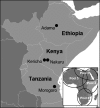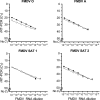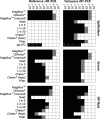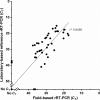Direct detection and characterization of foot-and-mouth disease virus in East Africa using a field-ready real-time PCR platform
- PMID: 28758346
- PMCID: PMC5811823
- DOI: 10.1111/tbed.12684
Direct detection and characterization of foot-and-mouth disease virus in East Africa using a field-ready real-time PCR platform
Abstract
Effective control and monitoring of foot-and-mouth disease (FMD) relies upon rapid and accurate disease confirmation. Currently, clinical samples are usually tested in reference laboratories using standardized assays recommended by The World Organisation for Animal Health (OIE). However, the requirements for prompt and serotype-specific diagnosis during FMD outbreaks, and the need to establish robust laboratory testing capacity in FMD-endemic countries have motivated the development of simple diagnostic platforms to support local decision-making. Using a portable thermocycler, the T-COR™ 8, this study describes the laboratory and field evaluation of a commercially available, lyophilized pan-serotype-specific real-time RT-PCR (rRT-PCR) assay and a newly available FMD virus (FMDV) typing assay (East Africa-specific for serotypes: O, A, Southern African Territories [SAT] 1 and 2). Analytical sensitivity, diagnostic sensitivity and specificity of the pan-serotype-specific lyophilized assay were comparable to that of an OIE-recommended laboratory-based rRT-PCR (determined using a panel of 57 FMDV-positive samples and six non-FMDV vesicular disease samples for differential diagnosis). The FMDV-typing assay was able to correctly identify the serotype of 33/36 FMDV-positive samples (no cross-reactivity between serotypes was evident). Furthermore, the assays were able to accurately detect and type FMDV RNA in multiple sample types, including epithelial tissue suspensions, serum, oesophageal-pharyngeal (OP) fluid and oral swabs, both with and without the use of nucleic acid extraction. When deployed in laboratory and field settings in Tanzania, Kenya and Ethiopia, both assays reliably detected and serotyped FMDV RNA in samples (n = 144) collected from pre-clinical, clinical and clinically recovered cattle. These data support the use of field-ready rRT-PCR platforms in endemic settings for simple, highly sensitive and rapid detection and/or characterization of FMDV.
Keywords: diagnostics; disease control; foot-and-mouth disease; foot-and-mouth disease virus; lyophilized; rRT-PCR.
© 2017 The Authors. Transboundary and Emerging Diseases Published by Blackwell Verlag GmbH.
Figures







Similar articles
-
Development and evaluation of tailored specific real-time RT-PCR assays for detection of foot-and-mouth disease virus serotypes circulating in East Africa.J Virol Methods. 2016 Nov;237:114-120. doi: 10.1016/j.jviromet.2016.08.002. Epub 2016 Aug 27. J Virol Methods. 2016. PMID: 27575682
-
Foot-and-mouth disease virus detection on a handheld real-time polymerase chain reaction platform.Transbound Emerg Dis. 2019 Jul;66(4):1789-1795. doi: 10.1111/tbed.13227. Epub 2019 Jun 5. Transbound Emerg Dis. 2019. PMID: 31077564
-
Evaluation of Two Lyophilized Molecular Assays to Rapidly Detect Foot-and-Mouth Disease Virus Directly from Clinical Samples in Field Settings.Transbound Emerg Dis. 2017 Jun;64(3):861-871. doi: 10.1111/tbed.12451. Epub 2015 Nov 30. Transbound Emerg Dis. 2017. PMID: 26617330 Free PMC article.
-
Investigating the temporal and spatial distribution of foot-and-mouth disease virus serotype C in the Region of South America, 1968-2016.Transbound Emerg Dis. 2019 Mar;66(2):653-661. doi: 10.1111/tbed.13069. Epub 2018 Dec 4. Transbound Emerg Dis. 2019. PMID: 30417550 Review.
-
A Review of the Utility of Established Cell Lines for Isolation and Propagation of the Southern African Territories Serotypes of Foot-and-Mouth Disease Virus.Viruses. 2024 Dec 30;17(1):39. doi: 10.3390/v17010039. Viruses. 2024. PMID: 39861828 Free PMC article. Review.
Cited by
-
Detection of foot-and-mouth disease virus RNA using a closed loop-mediated isothermal amplification system.Front Microbiol. 2024 Jul 31;15:1429288. doi: 10.3389/fmicb.2024.1429288. eCollection 2024. Front Microbiol. 2024. PMID: 39188314 Free PMC article.
-
Easy Express Extraction (TripleE)-A Universal, Electricity-Free Nucleic Acid Extraction System for the Lab and the Pen.Microorganisms. 2022 May 23;10(5):1074. doi: 10.3390/microorganisms10051074. Microorganisms. 2022. PMID: 35630515 Free PMC article.
-
A review of foot-and-mouth disease in Ethiopia: epidemiological aspects, economic implications, and control strategies.Virol J. 2023 Dec 15;20(1):299. doi: 10.1186/s12985-023-02263-0. Virol J. 2023. PMID: 38102688 Free PMC article. Review.
-
A highly effective reverse-transcription loop-mediated isothermal amplification (RT-LAMP) assay for the rapid detection of SARS-CoV-2 infection.J Infect. 2021 Jan;82(1):117-125. doi: 10.1016/j.jinf.2020.10.039. Epub 2020 Nov 30. J Infect. 2021. PMID: 33271166 Free PMC article.
-
"FastCheckFLI PPR-like"-A Molecular Tool for the Fast Genome Detection of PPRV and Differential Diagnostic Pathogens.Viruses. 2020 Oct 29;12(11):1227. doi: 10.3390/v12111227. Viruses. 2020. PMID: 33138260 Free PMC article.
References
-
- Ahmed, H. A. , Salem, S. A. , Habashi, A. R. , Arafa, A. A. , Aggour, M. G. , Salem, G. H. , … King, D. P. (2012). Emergence of foot‐and‐mouth disease virus SAT 2 in Egypt during 2012. Transboundary and Emerging Diseases, 59(6), 476–481. https://doi.org/10.1111/tbed.12015 - DOI - PubMed
-
- Almassian, D. R. , Cockrell, L. M. , & Nelson, W. M. (2013). Portable nucleic acid thermocyclers. Chemical Society Reviews, 42(22), 8769–8798. - PubMed
-
- Bachanek‐Bankowska, K. , Mero, H. R. , Wadsworth, J. , Mioulet, V. , Sallu, R. , Belsham, G. J. , … King, D. P. (2016). Development and evaluation of tailored specific real‐time RT‐PCR assays for detection of foot‐and‐mouth disease virus serotypes circulating in East Africa. Journal of Virological Methods, 237, 114–120. - PubMed
-
- Callahan, J. D. , Brown, F. , Osorio, F. A. , Sur, J. H. , Kramer, E. , Long, G. W. , … Nelson, W. M. (2002). Use of a portable real‐time reverse transcription‐polymerase chain reaction assay for rapid detection of foot‐and‐mouth disease virus. Journal of the American Veterinary Medical Association, 220, 1636–1642. - PubMed
-
- Ferris, N. P. , & Dawson, M. (1988). Routine application of enzyme‐linked immunosorbent assay in comparison with complement fixation for the diagnosis of foot‐and‐mouth and swine vesicular diseases. Veterinary Microbiology, 16(3), 201–209. - PubMed
MeSH terms
Substances
Grants and funding
LinkOut - more resources
Full Text Sources
Other Literature Sources
Molecular Biology Databases
Research Materials
Miscellaneous

